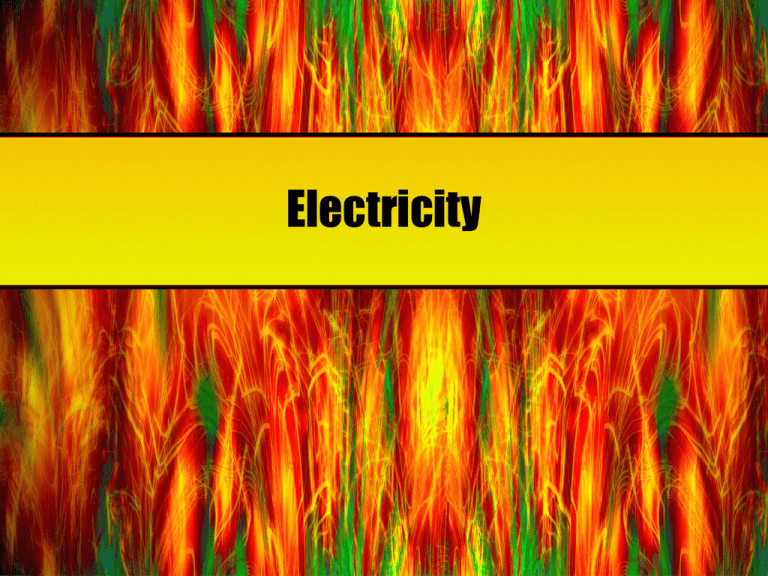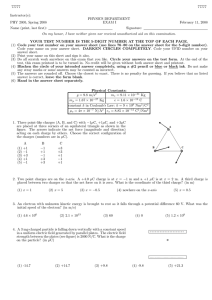Online PowerPoint Lecture
advertisement

Electricity Electric Charge and Force Charge: property of matter that creates electric and magnetic forces and interactions Observe property only through its effects Two types of charge: positive (+) and negative (-) Like charges repel, unlike charges attract --, ++: repel; +-, -+: attract Charge depends on imbalance of protons and electrons Excess of electrons: (-) Excess of protons: (+) SI Unit: Coulomb (C) Electron and proton have same magnitude of charge, but opposite signs Electron: -1.6 x 10-19 C Proton: 1.6 x 10-19 C Conductors: Easily transfer charge Charges move freely through material Metals, some metalloids Insulators: Transfer charge poorly Charges not able to move freely through material Nonmetals and some metalloids Methods of Charging Charging normally performed through movement of electrons Protons and neutrons relatively fixed in materials Electrons have greater freedom of movement Charging by friction When materials are rubbed together, electrons can be transferred between them One material gains electrons: becomes negatively charged One material loses electrons: becomes positively charged Conduction: charging through contact without rubbing Touch neutral object with charged object Electrons flow towards more positive object, creating charge on neutral object Induction: Charges on neutral object redistributed to create polarity Bring charged object in proximity to, but not touching, neutral object If charged object is (+): electrons attracted to side of neutral object closest to charged object If charged object is (-): electrons repelled to far side of neutral object Total charge on neutral object still 0 Electric Force Induction occurs through action of electric force Forces can create motion, push or pull Like charges have repelling electric force Unlike charges have attracting electric force Size of force depends on magnitude of charge and distance between objects Coulomb’s Law Example of an inverse-square law Used to calculate magnitude of electric force between two charged objects Formula: F = (kq1q2)/r2 F: electric force k: constant = 9 x 109 Nm2/C2 q1: charge on first object (C) q2: charge on second object (C) r: distance between objects 2 If value of electric force is negative, force is attractive +,- or -,+ If value of electric force is positive, force is repelling +,+ or -,Inverse-square nature of formula indicates that force diminishes quickly with distance Double the distance, force diminishes to one-fourth Force exerted through electric fields Example of a field force, like gravity Charged particle exerts electric field in space around it Another charged particle entering field experiences an electric force Electric fields can be represented by drawing electric field lines around charged particles Lines point away from + charges Lines point towards – charges Field lines never cross one another Fields strongest where lines are densest and greater charges are drawn with more field lines than weaker charges Electric Current Charges that accumulate on an object – static electricity Charges in motion – electric current Electric charges have potential energy based on position in electric field Like charges: highest potential energy when charges are close Unlike charges: highest potential energy when charges are at distance Often, potential difference is more useful to study than potential energy Potential difference occurs when a charge changes position in electric field Work that must be done against electric forces to move charge between points Potential difference = EPE/q SI unit: Volts 1 volt = 1 joule/coulomb Often called voltage Batteries Batteries function due to potential difference between terminals Convert chemical energy to electric energy One terminal (+), other is (-) Two components of battery Electrolyte: solution that conducts electricity Electrodes: two materials with different conducting ability Batteries can be dry cells or wet cells Dry cell: electrolyte is paste-like material Wet cell: electrolyte is liquid Voltage across terminals sets charges in motion Electrons move from negative terminal to positive terminal Connect terminals with wire and charges flow through wire to get to positive terminal Charges move from higher potential energy to lower potential energy Produces electric current Current: rate at which current moves through a conductor SI unit: ampere (A) 1 A = 1 coulomb/second Batteries produce direct current (DC) Charges always move in same direction Current can be made of positive or negative charges or a combination of the two Metals: negative charges Gases and chemical solutions: mix of positive and negative charges Conventional current defined as movement of positive charges Direction of current in a wire is opposite the direction of the movement of electrons in the wire Electric Resistance Resistance: opposition by material or device to flow of current Different wattage light bulbs shine with different brightness due to resistance across filament Voltage from outlet always 120 V Resistance created by internal friction Slows movement of charges in material Resistance difficult to measure directly Assess relationship between voltage across conductor and current through material Ohm’s Law: relates voltage, current and resistance R = V/I or V = IR SI unit for resistance: ohm (Ω) Resistor: component in circuit that provides specific resistance to flow of charges Collisions between moving charges and atoms of conductor increase kinetic energy of conductor atoms Material shows temperature increase Resistance affected by identity of material, temperature, length and cross-sectional area temperature, resistance length, resistance cross-section area, resistance Conductors have low resistance Some materials become superconductors below certain critical temperatures Insulators have high resistance Semiconductors are intermediate between conductors and insulators Circuits Electric circuit: set of electrical components connected such that they provide one or more complete paths for the movement of electrons Path between terminals of power source is complete Charges lose energy as travel through circuit and regain energy when travel through power source Circuits may be open or closed Closed circuit: path is complete and electrons flow Open circuit: path is broken in some area and electrons cease to flow Switches: devices for manually opening and closing a circuit On: circuit closed Off: circuit open Circuits visualized by using schematic diagrams Standard set of symbols to represent components of circuit Map out components of circuit in way that it is understood worldwide Types of Circuits When different devices are connected to power source, arrangement may vary Series circuit: Single pathway for electrons to flow Devices connected in linear fashion, one after another Electrons must flow through each device to complete circuit Current in each device is the same, but resistances may vary Different voltages across each device See different potential change across each device, if resistances vary If one device burns out or is removed, entire circuit ceases to function Parallel circuits: multiple paths for electrons to follow to complete circuit Break in one path does not interfere with other paths Voltage is same across each device, but current will vary according to device’s resistance Electric Power and Electric Energy Electric energy – type of energy needed for electric or electronic devices to run Electric power – rate at which electric energy is used in a circuit As charges travel circuit, they lose energy that is converted into work and is lost as heat P = VI SI unit: watt Power lost or dissipated by a circuit can be calculated: P = I2R or P = V2/R Electric energy used by home reported on monthly electric bill Electric meter tracks number of kilowatt-hours of energy used 1 kilowatt-hour = 3.6 x 106 J Set fixed cost per kilowatt hour Fuses and Circuit Breakers Mechanisms to protect circuits from overload Devices sensitive to electric energy – too much and wiring and components in device may be damaged Fuses inserted into circuit possess relatively weak filament that will burn out before a power surge reaches remainder of circuit Must be replaced when burned out Circuit breakers: respond to current overloads by opening the circuit Acts as a switch Can be reset by turning on circuit again Circuit breaker boxes have switch for every circuit in home Ground Fault Interrupters (GFI’s) monitor current in both wires connected to socket Change in current in a wire causes GFI to open circuit Touching bare wire would create current change and open circuit


